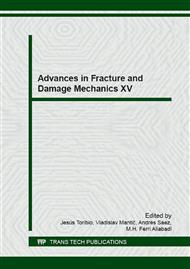[1]
G. Lamanna, F. Caputo, A. Soprano. Numerical investigation on the structural behavior of a composite impact absorber. Key Engineering Materials 417-418 (2010) 685-688.
DOI: 10.4028/www.scientific.net/kem.417-418.685
Google Scholar
[2]
F. Caputo, G. Lamanna, D. Scarano, A. Soprano. Numerical sensitivity analysis of a composite impact absorber. AIP Conference Proceedings 1042 (2008) 184-186.
DOI: 10.1063/1.2988994
Google Scholar
[3]
F. Caputo, G. Lamanna, A. Soprano. Energy absorption capabilities of a square tube system. Key Engineering Materials 488-489 (2012) 561-564.
DOI: 10.4028/www.scientific.net/kem.488-489.561
Google Scholar
[4]
F. Caputo, A. Soprano, G. Monacelli. Stochastic design improvement of an impact absorber. Latin American Journal of Solids and Structures 3(1) 2006 41-58.
Google Scholar
[5]
F. Caputo, A. De Luca, G. Lamanna, V. Lopresto, A. Riccio: Numerical investigation of onset and evolution of LVI damages in Carbon–Epoxy plates. Compos: Part B: Eng 68 (2015) 385–391.
DOI: 10.1016/j.compositesb.2014.09.009
Google Scholar
[6]
F. Caputo, G. Lamanna, A. De Luca, V. Lopresto: Numerical simulation of LVI test onto composite plates. AIP Conference Proceeding 1599 (2014) 335–8.
DOI: 10.1063/1.4876846
Google Scholar
[7]
A. Riccio, A. De Luca, G. Di Felice, F. Caputo: Modelling the simulation of impact induced damage onset and evolution in composites. Compos: Part B: Eng. 66 (2014) 340–7.
DOI: 10.1016/j.compositesb.2014.05.024
Google Scholar
[8]
F. Caputo, A. De Luca, G. Lamanna, R. Borrelli, U. Mercurio: Numerical study for the structural analysis of composite laminates subjected to low velocity impact. Composites Part B: Engineering 67 (2014) 296–302.
DOI: 10.1016/j.compositesb.2014.07.011
Google Scholar
[9]
F. Caputo, A. De Luca, G. Lamanna, R. Borrelli, F. Franchitti: Global-local FE Simulation of a plate LVI test. SDHM Structural Durability and Health Monitoring 9, 3 (2013) 253-267.
DOI: 10.32604/sdhm.2013.009.253
Google Scholar
[10]
Z. Hashin: Failure criteria for unidirectional composites. Journal Applied Mechanism 47 (1980) 329-334.
DOI: 10.1115/1.3153664
Google Scholar
[11]
F. Caputo, A. De Luca, R. Sepe: Numerical study of the structural behaviour of impacted composite laminates subjected to compression load. Compos Part B: Eng (2015) 79 456-465.
DOI: 10.1016/j.compositesb.2015.05.007
Google Scholar
[11]
A. Sellitto, R. Borrelli, F. Caputo, A. Riccio, F. Scaramuzzino: Application of the mesh superposition technique to the study of delaminations in composites thin plates. Key Engineering Materials 525-526 (2012) 533-536.
DOI: 10.4028/www.scientific.net/kem.525-526.533
Google Scholar


